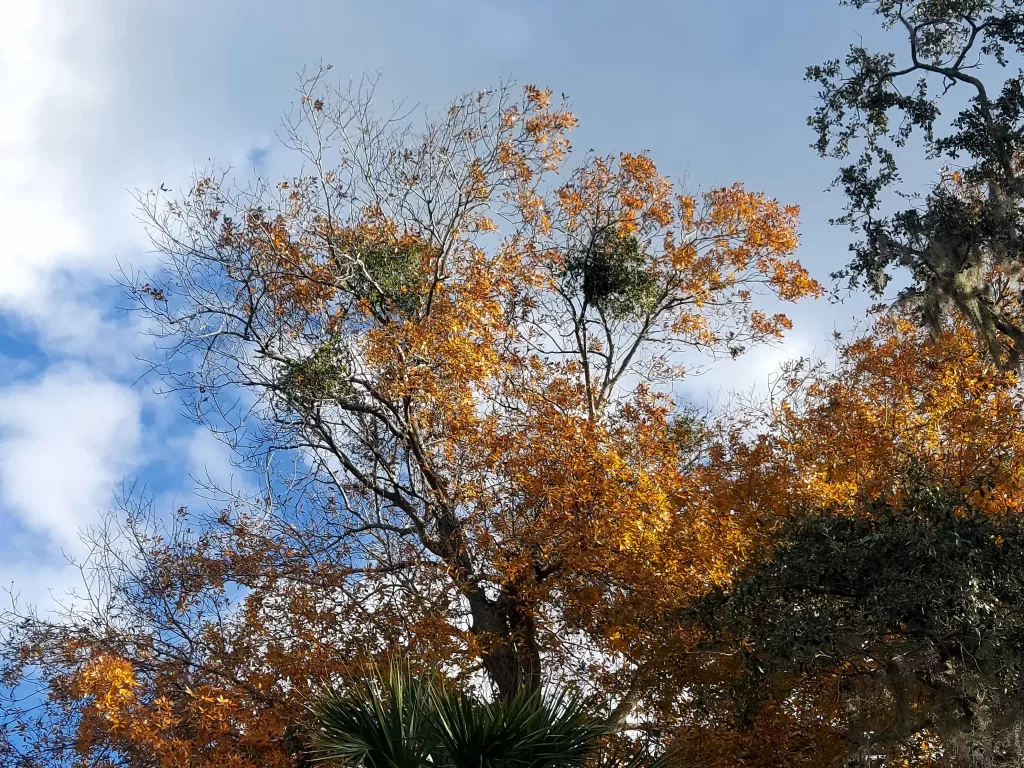Underneath the Mistletoe: The Meaning Behind the Myth

I saw Mommy kissing Santa Claus
Underneath the mistletoe last night.
So I decided to do some digging – not into who exactly this Santa Claus was or why Mommy was kissing him, but into the object that spurred their smooch: mistletoe. In this article, we will discuss this locally-found plant, its traditional uses, and the myths associated with it.
Mistletoe’s most common species in Georgia is oak mistletoe, which can be found in circular bunches high on tree branches from Kansas to New Jersey. In South Georgia and Florida, mistletoe is most commonly found on laurel oaks, but it can grow on dozens of other deciduous tree species such as elms, hackberries, sycamores, and wild cherry trees. Although it grows all year long, it is mostly hidden in summer by a tree’s thick foliage and only becomes visible after autumn leaves have fallen.

What’s In A Name?
When a sticky mistletoe seed lands on a suitable tree limb (often via bird droppings), the seed sends out “roots” that penetrate the tree and connect with the growing ring of the host. Its name derives from this process: “Mistletoe” is a blending of the Anglo-Saxon “mistle” for dung (in this case, bird droppings) and “toe” for twig.
Mistletoe’s botanical name, Phoradendron leucarpum, is Greek for “thief of a tree with white fruit.” In fact, mistletoe is a “thief,” or semi-parasitic. Although mistletoe produces chlorophyll, allowing it to make food through photosynthesis, its roots suck water and nutrients from its host tree for growth.
Mistletoe is not all destructive. The oak variety produces white berries – each containing one seed – which are mildly toxic to humans but are consumed by an array of wildlife, including bears, squirrels, chipmunks, bluebirds, robins, chickadees, and mourning doves. Mistletoe is also the host plant for the caterpillar of the great purple hairstreak butterfly.
Tales As Old As Time
The tradition of hanging mistletoe over doorways began in ancient times, when people thought it had mystical powers due to its seemingly rootless nature. Celtic Druids believed mistletoe was holy because it grew closer to heaven than any other plant, and they displayed branches to celebrate the New Year. They believed its evergreen leaves symbolized the promise of spring’s return.
In Ancient Rome, bunches were placed over doorways as a symbol of peace and to protect households from danger. Mistletoe also was hung during Saturnalia, the Roman festival held in December, from which many Christmas traditions have evolved.
Kissing under this evergreen derives from cultures which considered the plant a symbol of fertility. Mistletoe – the sacred symbol of Frigga, the Viking goddess of love – was used to promote long, fruitful marriages. By the 1700s in France and England, these beliefs had evolved into a tradition: A man could kiss any woman standing beneath the plant he desired. If she refused, bad luck would befall her. Today, mistletoe is a symbol of love, fertility, and good luck.
Mistletoe is not just a decoration; mistletoe teas and extracts have been used in folk medicine as a treatment for everything from migraines and rheumatism to high blood pressure. However, today its medical use remains controversial due to its toxicity.
Grab A Bunch!
Your collecting mistletoe to decorate your home could save its host tree from being weakened or destroyed. The old-fashioned way to harvest mistletoe required shooting sprigs down with a shotgun, but you may expel mistletoe more effectively by pruning: remove the mistletoe’s roots by pruning the infested branch at least six inches below where the mistletoe is attached. However, this method may damage the tree’s structure. The easiest and safest way to acquire fresh mistletoe is by purchasing it at a store.
You may refrigerate freshly cut sprigs to keep them fresh until you are ready to prepare them for decorative use. Once you have decorated with your mistletoe, mist the sprig daily to keep it looking fresh. Be sure that after handling mistletoe, you wash your hands thoroughly with hot, soapy, water.
Now the next time you see Mommy and Santa Claus kissing under the mistletoe, you may interject with fascinating tidbits on this decorative plant. I am sure they will appreciate it!
Find mistletoe yourself on our Cumberland Island Walking Tour or one of our St. Marys tours!



